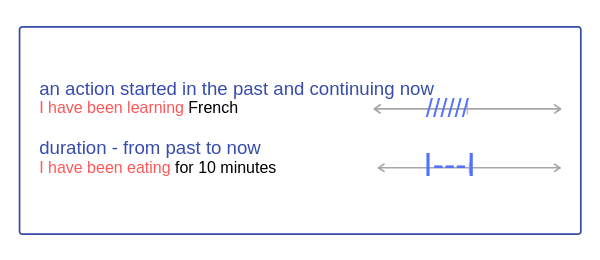Present Perfect Continuous
timeline, form, uses

The Present Perfect Continuous is used to talk about the duration of an action or state that started in the past and is continuing in the present. Below we’ll explore the Present Perfect Continuous timeline, form, uses, with examples.
It is also called the Present Perfect Progressive.
TO FORM THE PRESENT PERFECT CONTINUOUS
The Present Perfect Continuous is formed of 3 parts:
– auxiliary verb to have in the Present Simple tense (have / has)
– auxiliary verb to be in the Past Participle (been)
– main verb in the Present Participle (ending +ing)

affirmative: subject + auxiliary (to have) + auxiliary (to be) + main verb
negative: subject + auxiliary (to have) + not + auxiliary (to be) + main verb
questions: auxiliary (to have) + subject + auxiliary (to be) + main verb
negative questions: auxiliary (to have) + subject + not + auxiliary (to be) + main verb
Forms in the Present Perfect Continuous of the verb to talk:
affirmative
I have been talking
you have been talking
he/she/it has been talking
we have been talking
you have been talking
they have been talking
negative
I have not been talking
you have not been talking
he/she/it has not been talking
we have not been talking
you have not been talking
they have not been talking
questions
have I been talking?
have you been talking?
has he/she/it been talking?
have we been talking?
have you been talking?
have they been talking?
negative questions
have I not been talking?
have you not been talking?
has he/she/it not been talking?
have we not been talking?
have you not been talking?
have they not been talking?
PRESENT PERFECT CONTINUOUS USES
to talk about an action started in the past and that may or may not be continuing in the present
I have been taking cookery classes. (and I am still taking the classes)
The choir have been singing all afternoon (and are still singing now).
The choir have been singing all afternoon and are taking a break now.
with for and since to indicate a time period for an action that started in the past
Since last February I have been taking cookery classes.
Mary has been seeing a new doctor for the last two months.
CONTRACTED AUXILIARY VERBS
The Present Perfect Continuous uses the verb to have in the Present Simple as an auxiliary verb. Auxiliary verbs are often contracted, especially in spoken and informal written language. The contracted forms are:
| affirmative | contracted |
| I have | I’ve |
| you have | you’ve |
| he/she/it has | he’s / she’s / it’s |
| we have | we’ve |
| you have | you’ve |
| they have | they’ve |
| negative | contracted |
| I have not | I haven’t |
| you have not | you haven’t |
| he/she/it has not | he/she/it hasn’t |
| we have not | we haven’t |
| you have not | you haven’t |
| they have not | they haven’t |
| negative question | contracted |
| have I not? | haven’t I? |
| have you not? | haven’t you? |
| has he/she/it not? | hasn’t he/she/it? |
| have we not? | haven’t we? |
| have you not? | haven’t you? |
| have they not? | haven’t they? |
More on contracted auxiliary verbs
Present Perfect Progressive timeline, form, uses